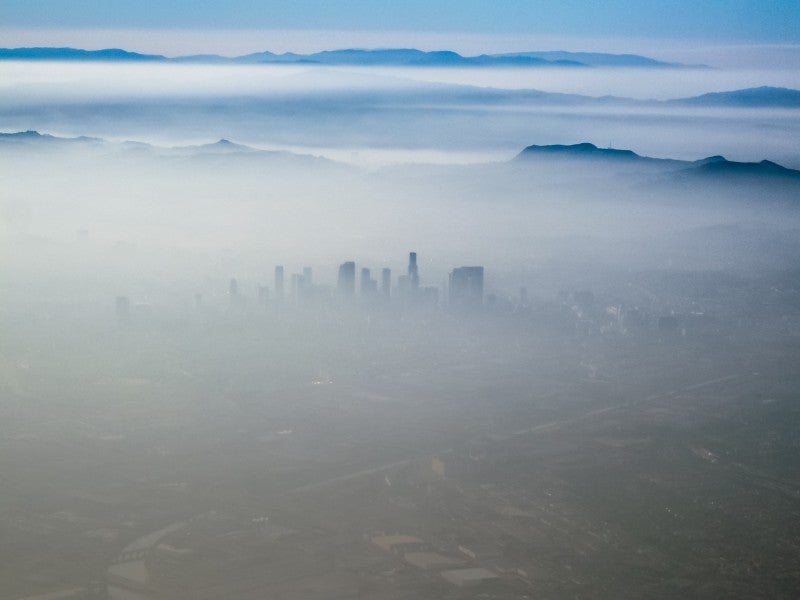Air Pollution Makes COVID-19 More Deadly
Staff Scientist Rashmi Joglekar explains how a new Harvard study adds to a growing pile of evidence that we must enforce stricter regulations on toxic emissions to save lives.
As the coronavirus tears through communities around the world, a new Harvard study has shown that long-term exposure to fine particulate matter, a component of air pollution, is linked to a greater chance of dying from COVID-19. The results add to a growing body of evidence that we must adopt and enforce stricter regulations on toxic releases in order to save lives. Yet the Trump administration seems adamant about doing the opposite.
The study, which was released pre-publication, shows a striking association between long-term exposure to harmful fine particulate matter, called PM2.5, and COVID-19 mortality in the United States. The primary cause of PM 2.5 pollution is combustion from car engines and coal or gas power plants. Researchers highlighted that in counties affected by COVID-19, just a small increase in PM 2.5 pollution is associated with a large increase in COVID-19 death rate. While small increases in PM 2.5 pollution are associated with increased mortality from a variety of causes, researchers found that the increase in COVID-19 mortality associated with PM 2.5 was 20 times higher than all other causes. In other words, individuals living in areas polluted with PM2.5 are more likely to die from COVID-19.
This isn’t the first time researchers have noticed this type of deadly connection. Previous studies examining the 2003 SARS outbreak in China caused by a closely related strain of coronavirus, also found higher death rates among individuals living in polluted areas.
Manhattan, which has one of the highest rates of COVID-19 infection and death in the U.S., provides a frightening glimpse into the consequences of high levels of PM2.5 pollution. The Harvard researchers estimated that if long-term average PM2.5 pollution in Manhattan was even slightly lower, some 250 lives could have been spared just last week based on the COVID-19 mortality rates.
The state of Louisiana provides additional support for this toxic trend. Nestled in the heart of the petrochemical industry, some areas of southeastern Louisiana are so polluted that they have been given the name “Cancer Alley” due to high incidence of cancer in these communities. St. John the Baptist Parish, for example, is situated within Cancer Alley, and reports one of the highest COVID-19 death rates per capita in the United States. Even before the pandemic struck, community groups in St. John and elsewhere in Cancer Alley were calling for reductions in toxic air pollutants by urging EPA to strengthen national emission standards for chemical manufacturing plants, and by opposing dangerous new toxic emitters like the Formosa petrochemical complex proposed in St. James Parish. It might come as no surprise that a large portion of Cancer Alley residents who live on the fenceline of these toxic facilities are black.
“Taken together, these data show that communities would benefit tremendously from decreased air pollution and stronger, more protective air regulations,” says Michelle Mabson, a Staff Scientist in the Healthy Communities program at Earthjustice.
These startling trends bring to light an association that decision makers should not ignore: one between environmental exposures and vulnerability to infectious disease. Long- and short-term exposure to environmental pollutants can have devastating impacts on human health. In light of the coronavirus pandemic, the most dangerous pollutants are those that affect our greatest defense mechanism: the immune system. Exposure to PM 2.5 induces lung inflammation, which can weaken the clearance of infectious agents like bacteria and viruses in the lungs. Similar to PM 2.5, other combustion byproducts are also associated with immunosuppression. As another example, PFAS, a class of toxic chemicals that have made their way into the bodies of more than 95% of Americans due to presence in consumer products and drinking water, have been liked to suppression of the antibody response, a critical mechanism for developing immunity against infectious diseases like COVID-19.
We must ensure that communities living in polluted areas like St. John the Baptist Parish are not at a heightened risk for adverse health outcomes and susceptibility to infectious diseases. For this to become a reality, state and federal governments will have to enforce stricter regulations on the use and release of toxic substances, including on the burning of fossil fuels that results in dangerous PM2.5 pollution. It is also critical to use tools that already exist, like publicly-available data sets on pollution and disease rates, to pinpoint vulnerable communities and better address existing disparities that worsen these associations.
These measures are especially relevant due to our current administration’s efforts to dismantle protective environmental regulations. As just one example, the Trump administration’s proposed rollback of the Mercury and Air Toxics Standards (MATS), a rule that was enacted to reduce toxic air pollution, could result in 11,000 premature deaths and billions of dollars in healthcare costs from increased exposure to toxic air pollutants like PM 2.5. These estimates do not even take into account the additional costs associated with increased COVID-19 deaths from PM2.5 exposure.
Now more than ever, it is critical to keep environmental rules in place that protect communities from the adverse health impacts of toxic pollution, including death from COVID-19.
Learn how Earthjustice is fighting for clean air in every community.
Earthjustice’s Toxic Exposure & Health Program uses the power of the law to ensure that all people have safe workplaces, neighborhoods, and schools; have access to safe drinking water and food; live in homes that are free of hazardous chemicals; and have access to safe products.
